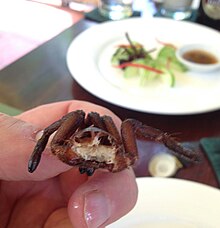

|
Tags: Mobile edit Mobile web edit Advanced mobile edit
|
Tags: Mobile edit Mobile web edit Advanced mobile edit
|
||
| Line 20: | Line 20: | ||
<references/> |
<references/> |
||
[[Category:Arachnids as food]] |
|||
[[Category:Foods]] |
[[Category:Foods]] |
||
[[Category:Spiders]] |
[[Category:Spiders]] |
||
Arachnophagy (/əˈræknɒfədʒi/, from Greek ἀράχνη aráchnē, 'spider', and φαγεῖν phagein, 'to eat') describes a feeding behaviour that includes arachnids. Aside from non-human creatures, the term can also refer to the practice of eating arachnids among humans.[1]

Arachnophagy is widespread among many animals, especially reptiles and birds. For example, arachnophagy is described among Philippine scops owls that feed on spider species such as Heteropoda venatoria.[2]



Like the human consumption of insects (entomophagy), arachnids as well as myriapods also have a history of traditional consumption, either as food or medicine. Arachnids include spiders, scorpions, mites and ticks that are consumed by humans worldwide.[3]
Fried spider, primarily tarantula species, is a regional snack in Cambodia. In Mexico, tarantula have been offered in tacos, with a splash of guacamole.[4] However, Mexican law forbids the sale of many species of tarantula for human consumption, and vendors offering this delicacy have been shut down by authorities.[5]
Fried scorpion is traditionally eaten in Shandong, China.[6]
Milbenkäse (mite cheese) is a German speciality cheese.